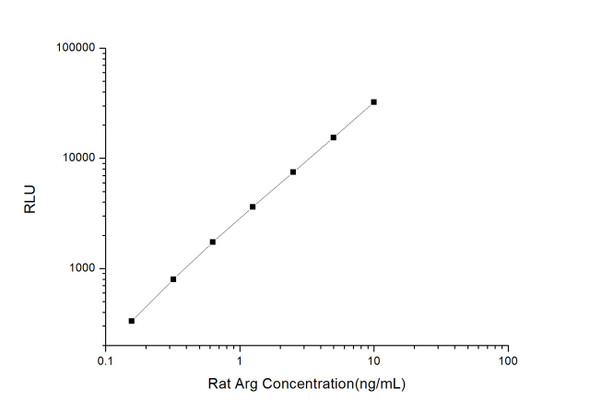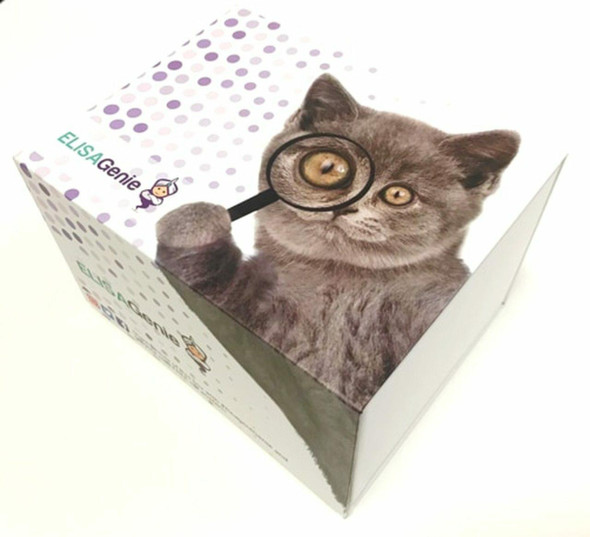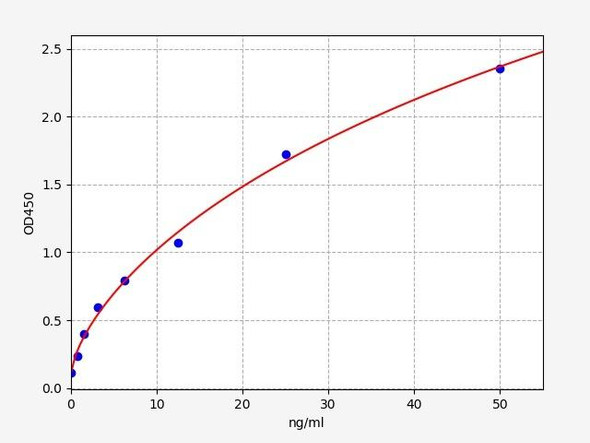Human Immunology ELISA Kits 1
Human Arg 1(Arginase I) CLIA Kit (HUES00354)
- SKU:
- HUES00354
- Product Type:
- ELISA Kit
- ELISA Type:
- CLIA Kit
- Size:
- 96 Assays
- Sensitivity:
- 0.47ng/mL
- Range:
- 0.78-50ng/mL
- ELISA Type:
- Sandwich
- Synonyms:
- ARG1, Arginase I, Liver Arginase
- Reactivity:
- Human
- Sample Type:
- Serum, plasma and other biological fluids
- Research Area:
- Immunology
Description
| Assay type: | Sandwich |
| Format: | 96T |
| Assay time: | 4.5h |
| Reactivity: | Human |
| Detection method: | Chemiluminescence |
| Detection range: | 0.78-50 ng/mL |
| Sensitivity: | 0.47 ng/mL |
| Sample volume: | 100µL |
| Sample type: | Serum, plasma and other biological fluids |
| Repeatability: | CV < 15% |
| Specificity: | This kit recognizes Human Arg 1 in samples. No significant cross-reactivity or interference between Human Arg 1 and analogues was observed. |
This kit uses Sandwich-CLIA as the method. The micro CLIA plate provided in this kit has been pre-coated with an antibody specific to Human Arg1. Standards or samples are added to the appropriate micro CLIA plate wells and combined with the specific antibody. Then a biotinylated detection antibody specific for Human Arg1 and Avidin-Horseradish Peroxidase (HRP) conjugate are added to each micro plate well successively and incubated. Free components are washed away. The substrate solution is added to each well. Only those wells that contain Human Arg1, biotinylated detection antibody and Avidin-HRP conjugate will appear fluorescence. The Relative light unit (RLU) value is measured spectrophotometrically by the Chemiluminescence immunoassay analyzer. The RLU value is positively associated with the concentration of Human Arg1. The concentration of Human Arg1 in the samples can be calculated by comparing the RLU of the samples to the standard curve.
| UniProt Protein Function: | ARG1: Homotrimer. By arginine or homoarginine. Belongs to the arginase family. 3 isoforms of the human protein are produced by alternative splicing. |
| UniProt Protein Details: | Protein type:Amino Acid Metabolism - arginine and proline; EC 3. 5. 3. 1; Hydrolase Chromosomal Location of Human Ortholog: 6q23. 2 Cellular Component: cytoplasm; cytosol; extracellular region; nucleus Molecular Function:arginase activity Biological Process: arginine catabolic process; neutrophil degranulation; urea cycle Disease: Argininemia |
| NCBI Summary: | Arginase catalyzes the hydrolysis of arginine to ornithine and urea. At least two isoforms of mammalian arginase exist (types I and II) which differ in their tissue distribution, subcellular localization, immunologic crossreactivity and physiologic function. The type I isoform encoded by this gene, is a cytosolic enzyme and expressed predominantly in the liver as a component of the urea cycle. Inherited deficiency of this enzyme results in argininemia, an autosomal recessive disorder characterized by hyperammonemia. Two transcript variants encoding different isoforms have been found for this gene. [provided by RefSeq, Sep 2011] |
| UniProt Code: | P05089 |
| NCBI GenInfo Identifier: | 12230985 |
| NCBI Gene ID: | 383 |
| NCBI Accession: | P05089. 2 |
| UniProt Secondary Accession: | P05089,Q5JWT5, Q5JWT6, Q8TE72, Q9BS50, A6NEA0, |
| UniProt Related Accession: | P05089 |
| Molecular Weight: | 35kDa |
| NCBI Full Name: | Arginase-1 |
| NCBI Synonym Full Names: | arginase 1 |
| NCBI Official Symbol: | ARG1 |
| NCBI Protein Information: | arginase-1 |
| UniProt Protein Name: | Arginase-1 |
| UniProt Synonym Protein Names: | Liver-type arginase; Type I arginase |
| Protein Family: | Arginase |
| UniProt Gene Name: | ARG1 |
As the RLU values of the standard curve may vary according to the conditions of the actual assay performance (e. g. operator, pipetting technique, washing technique or temperature effects), the operator should establish a standard curve for each test. Typical standard curve and data is provided below for reference only.
| Concentration (ng/mL) | RLU | Average | Corrected |
| 50 | 34497 39465 | 36981 | 36959 |
| 25 | 13881 16249 | 15065 | 15043 |
| 12.5 | 7072 6528 | 6800 | 6778 |
| 6.25 | 3046 3636 | 3341 | 3319 |
| 3.13 | 1864 1694 | 1779 | 1757 |
| 1.56 | 1091 991 | 1041 | 1019 |
| 0.78 | 649 715 | 682 | 660 |
| 0 | 21 23 | 22 | -- |
Precision
Intra-assay Precision (Precision within an assay): 3 samples with low, mid range and high level Human Arg 1 were tested 20 times on one plate, respectively.
Inter-assay Precision (Precision between assays): 3 samples with low, mid range and high level Human Arg 1 were tested on 3 different plates, 20 replicates in each plate.
| Intra-assay Precision | Inter-assay Precision | |||||
| Sample | 1 | 2 | 3 | 1 | 2 | 3 |
| n | 20 | 20 | 20 | 20 | 20 | 20 |
| Mean (ng/mL) | 2.65 | 7.01 | 23.80 | 2.63 | 7.39 | 22.27 |
| Standard deviation | 0.24 | 0.74 | 2.35 | 0.30 | 0.74 | 1.61 |
| C V (%) | 9.06 | 10.56 | 9.87 | 11.41 | 10.01 | 7.23 |
Recovery
The recovery of Human Arg 1 spiked at three different levels in samples throughout the range of the assay was evaluated in various matrices.
| Sample Type | Range (%) | Average Recovery (%) |
| Serum (n=5) | 88-101 | 93 |
| EDTA plasma (n=5) | 91-104 | 96 |
| Cell culture media (n=5) | 90-105 | 97 |
Linearity
Samples were spiked with high concentrations of Human Arg 1 and diluted with Reference Standard & Sample Diluent to produce samples with values within the range of the assay.
| Serum (n=5) | EDTA plasma (n=5) | Cell culture media (n=5) | ||
| 1:2 | Range (%) | 96-111 | 88-100 | 96-110 |
| Average (%) | 103 | 93 | 104 | |
| 1:4 | Range (%) | 92-106 | 93-105 | 97-111 |
| Average (%) | 99 | 99 | 105 | |
| 1:8 | Range (%) | 101-117 | 86-99 | 92-102 |
| Average (%) | 108 | 93 | 97 | |
| 1:16 | Range (%) | 97-114 | 101-118 | 95-106 |
| Average (%) | 104 | 108 | 100 |
An unopened kit can be stored at 4°C for 1 month. If the kit is not used within 1 month, store the items separately according to the following conditions once the kit is received.
| Item | Specifications | Storage |
| Micro CLIA Plate(Dismountable) | 8 wells ×12 strips | -20°C, 6 months |
| Reference Standard | 2 vials | |
| Concentrated Biotinylated Detection Ab (100×) | 1 vial, 120 µL | |
| Concentrated HRP Conjugate (100×) | 1 vial, 120 µL | -20°C(shading light), 6 months |
| Reference Standard & Sample Diluent | 1 vial, 20 mL | 4°C, 6 months |
| Biotinylated Detection Ab Diluent | 1 vial, 14 mL | |
| HRP Conjugate Diluent | 1 vial, 14 mL | |
| Concentrated Wash Buffer (25×) | 1 vial, 30 mL | |
| Substrate Reagent A | 1 vial, 5 mL | 4°C (shading light) |
| Substrate Reagent B | 1 vial, 5 mL | 4°C (shading light) |
| Plate Sealer | 5 pieces | |
| Product Description | 1 copy | |
| Certificate of Analysis | 1 copy |
- Set standard, test sample and control (zero) wells on the pre-coated plate and record theirpositions. It is recommended to measure each standard and sample in duplicate. Note: addall solutions to the bottom of the plate wells while avoiding contact with the well walls. Ensuresolutions do not foam when adding to the wells.
- Aliquot 100µl of standard solutions into the standard wells.
- Add 100µl of Sample / Standard dilution buffer into the control (zero) well.
- Add 100µl of properly diluted sample (serum, plasma, tissue homogenates and otherbiological fluids. ) into test sample wells.
- Cover the plate with the sealer provided in the kit and incubate for 90 min at 37°C.
- Aspirate the liquid from each well, do not wash. Immediately add 100µL of BiotinylatedDetection Ab working solution to each well. Cover the plate with a plate seal and gently mix. Incubate for 1 hour at 37°C.
- Aspirate or decant the solution from the plate and add 350µL of wash buffer to each welland incubate for 1-2 minutes at room temperature. Aspirate the solution from each well andclap the plate on absorbent filter paper to dry. Repeat this process 3 times. Note: a microplatewasher can be used in this step and other wash steps.
- Add 100µL of HRP Conjugate working solution to each well. Cover with a plate seal andincubate for 30 min at 37°C.
- Aspirate or decant the solution from each well. Repeat the wash process for five times asconducted in step 7.
- Add 100µL of Substrate mixture solution to each well. Cover with a new plate seal andincubate for no more than 5 min at 37°C. Protect the plate from light.
- Determine the RLU value of each well immediately.






